A few months ago, a reader remarked favorably on our ongoing holster tests. The reader said that his orthopedic doctor opined that those carrying concealed handguns are best served with a shoulder holster. This load-bearing harness takes the weight of a handgun off the belt and puts it on the shoulders, so that the weight is better balanced over a wider area. And, like the cowboy’s rig or a cop’s duty belt, a properly-designed shoulder holster will carry a handgun, spare magazines, and even a knife on one rig.
Okay, all good. But here are some quirks to balance the scales. The shoulder holster is only viable when a covering garment may be worn. Also, there are issues with the draw that must be addressed. The shoulder holster demands more practice and training than a strong-side holster. The shoulder holster is more difficult to adjust, and a quality shoulder holster is more expensive than a strong-side holster, in most cases. Also, many trainers disparage shoulder holsters, and for one very good reason. The raters who are also trainers, as examples, cannot allow shoulder holsters during classes, but only in carefully supervised individual training. This is because the draw allows the muzzle to sweep others to the side and behind the wearer.
History
It is difficult to trace the development of the shoulder holster, but it is a type that was in general use in the American Civil War. The crossdraw developed first, we believe, but the shoulder holster became popular when laws against open carry and carrying handguns were passed in the Old West. A concealable rig was needed. The shoulder holster was simple at first, but eventually developed into a holster that typically featured a loop over the left shoulder (for right-handed holsters) and a stabilizing component of some type running across the chest, but later running across the back and meeting another loop on the opposite side. While the shoulder holster is associated with gamblers, many peace officers also wore the type. At one time, it was not allowed for peace officers in many northern cities to carry the handgun exposed. Most carried a small 32 or 38 revolver in the pocket of their uniform tunic. Others carried more serious armament in a shoulder holster. One of our raters remembers officers carrying a 38 Special revolver by regulation, but there were no regulations against a second firearm. Many officers carried a 357 Magnum, 44 Magnum, or 45 Colt revolver in a shoulder holster. This type of demand resulted in excellent designs. Of course, there were cheap ones as well.
Is the Shoulder Holster a Real World Option?
Just the same, in real-world use the shoulder holster is useful. Don’t let a training-range mentality confuse the issue and knock out some very practical holsters.
In terms of everyday carry use, some say the shoulder holster is difficult to adjust properly. This is more true of cheap examples, but even the good examples require time to get the “ride” correctly adjusted. Once properly adjusted — and having a helper goes a long way — an advantage is that the handgun and the spare ammunition are carried in one unit. Simply don the rig and go about your business. Female shooters find the shoulder holster works well for them. People spending much of their time driving or seated will find shoulder holsters offer an efficient draw. The handgun is well concealed but accessible.
Speed and safety are constant concerns with any system. The strong-side draw is faster and more natural: the elbow shoots to the rear and the handgun is scooped from the holster. The shoulder holster demands reaching across the body and drawing the handgun. When the handgun is carried in a horizontal shoulder holster, the muzzle covers everyone that is in the area behind the shooter. One of our raters is a major in the service with much experience. He mentioned that shoulder holsters were often worn by back-area officers, and they swept the whole dining hall with their muzzle at dinner. The draw covers anyone on the firing line during practice, which is why the shoulder holster isn’t allowed in training. The proper draw, which we used during the testing, is to stand angled to the target. The right side foot moves to the rear as the body is bladed to the target. The handgun is drawn as the left side (or non dominant side) hand is raised to avoid the muzzle covering the shooter’s weak-side arm. The hands then meet and the pistol is pressed toward the target. This is much faster than awkwardly reaching across the chest without a practiced technique.
Types of Shoulder Holsters
The types of shoulder holsters are defined by the way they carry the handgun. Vertical, horizontal, and upside down are among the choices.
- The chest holster isn’t easily concealed and is generally used for military duty and hunting.
- The upside-down shoulder holster hangs the handgun with the muzzle directly into the armpit. It is useful for small revolvers. The handgun is retained by a strong steel spring.
- The vertical rig retains the handgun with the muzzle pointed down.
- The horizontal shoulder holster demands the handgun is carried with the muzzle to the rear and butt forward.
All offer a hidden draw. The arms may be crossed and the hand placed on the gun under the garment, yet the draw isn’t obvious until it begins.
The upside-down holster is limited by the armpit as to the length of the handgun. The muzzle-into-the-armpit carry is disconcerting to some shooters. They offer good concealment, but only for a small-frame handgun, such as a 2-inch-barrel revolver. It is difficult to get a good firing grip quickly.
The vertical holster with the muzzle down allows the carry of relatively large and heavy handguns. Since they attach to the belt, they sacrifice some concealment. While a shorter covering garment may conceal a horizontal holster, this isn’t the case with the vertical type. The horizontal holster places the gun butt in a position to be grasped quickly during the draw. But then the handgun used is limited in size to the user’s build. The muzzle may print on the coat if the slide or barrel is long enough. A final difference in shoulder holsters is that some demand the holster and support webbing be attached to the belt. Others are free standing.
When you choose a holster, there are several important considerations. The handgun should be chosen first, but a realistic appraisal of appropriate garments and our body size must be part of the equation as well. Let’s face it, older shooters to whom the shoulder holster is well suited have a different fashion sense and may wear oversized shirts and windbreakers and not look out of place. The mass and weight of the gun affect holster selection and how the handgun may be concealed. Of all the concealment systems, the shoulder holster represents the smallest penalty for carrying a heavy handgun. A reasonably comfortable shoulder holster is better than a bearable holster and is superior to a chafing pain in the side.
Adapting to the shoulder holster demands a longer acclimation period. It is worthwhile. Another consideration is that the shoulder holster is basically a crossdraw holster. This draw is a little slower than a true crossdraw in most instances and slower than the strong-side holster. But it is superior as weight-bearing ability goes.
With these general observations in mind, we obtained several holsters for testing and evaluation. The goal was for a rater to wear the holster for at least one week, while going about daily chores and commuting, and to execute at least 100 presentations. The first few draws were for familiarization; the next would have to be from concealed carry. We rated the holsters on draw speed, comfort, and level of adjustment. We turned them upside down and shook them to test retention. What follows is how the holsters stacked up according to the experiences of our test-team members.
Viper Holsters Shoulder Rig, $159
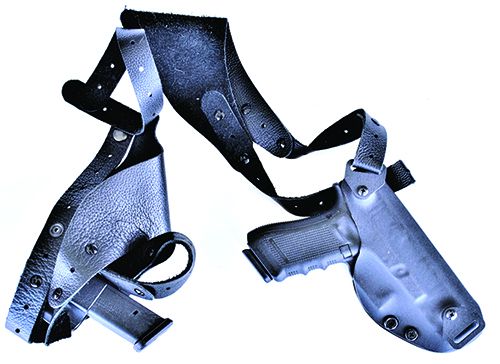
This was available from ViperHolsters.com. The Viper is a combination of leather and Kydex. The rater ordered this holster for his personal Glock 17. In general, we like to order holsters for service-grade full-size handguns for testing. The added size and weight are more likely to show a defect or difficulty in carrying the handgun than if we were to test a holster for the Glock 43 or a snubnose 38 Special.
Our Team Said: This is a vertical holster. The holster component itself is Kydex. As such, it is rugged and impervious to oil and solvent. The fit is excellent. The handgun snaps smartly into place and is held securely by the long bearing surfaces. The holster harness is of quality leather. While thin so as not to print on covering garments, the leather is strong and did a good job of supporting the Glock pistol. The straps and catches offer good adjustment. The draw was sharp. The angle is slightly butt forward, making for good access. We like the single angled magazine pouch. We went a bit beyond the design parameters in one test by not using the belt snaps and donning a light windbreaker, so the rig hung loosely. This isn’t ideal, but we found the handgun hung well and the draw remained reasonably good. Not recommended, but possible. This Viper system is a good one.
GUN TESTS GRADE: A
Wright Leather Works Maverick, $254
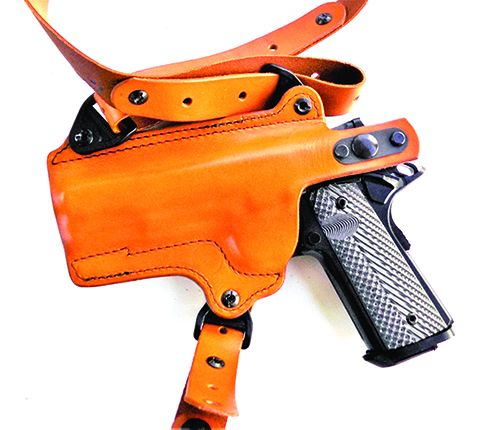
You can find this at WrightLeatherworks.com. The Maverick may be purchased as a holster harness, the holster and magazine may be purchased separately, and the holster may be ordered without a magazine carrier. The Maverick is a horizontal-type shoulder holster. The leather work and stitching are excellent. The holster itself features a good tight fit and excellent stitching, with a holstering welt at the holster mouth. The spine is thicker on the bottom than the top. The leather weight-bearing harness attaches to the strong spine. (The spine is the leather support around the holster.) The holster is molded to the individual handgun well. As an example, the holster tested is for a 1911 handgun, while the SIG 1911, with its unique slide design setting it apart from other 1911 handguns, will not fit. The thumb break is reinforced and positive in operation. The harness is held together by Chicago screws. There is a great deal of adjustment in the Maverick.
The Maverick features security straps for both the holster and the magazine carrier that attach to the belt. While theoretically you could deploy the holster without these stabilizing straps, we really like the security they afford. Horizontal shoulder holsters such as this one may work without these straps in place, but the vertical shoulder holster will not. The dual magazine carrier accepts two 1911 magazines. This carrier doesn’t have flaps to hold the magazines in place. Rather, the horizontal carrier features tension adjustment to maintain retention. The user may adjust the tension screws to maintain the magazines in place as tightly as he or she desires. We recommend maintaining tension that amounts to a strong tug. With the stabilizing strap in place, the tug released the magazine readily. With the magazine carrier less stabilized without the strap attached to the belt, a draw required the carrier be brought out to the end of its travel against the shoulder strap with the preferred adjustment. The holster is designed to be worn with stabilizing straps, and they really do the business.
Our Team Said: After several raters took turns wearing this holster, we found it to be a good choice. We especially like the X hook up for the shoulder straps that lays across the back of the shooter. The leather was stiff for the first few days, as expected. The magazine-carrier design is especially useful.
GUN TESTS GRADE: A
Galco Jackass, $152
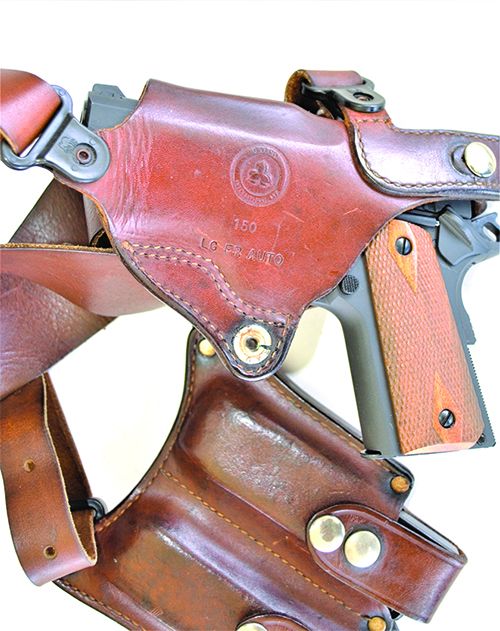
We found the holster at Botach.com for about $50 off MSRP, so be certain to shop around. Some places asked $100 more than average. This holster has a certain amount of pop-culture appeal because it was worn by actor Don Johnson in the majority of Miami Vice episodes. While this was a shot in the arm for Galco marketing, the holster prospered based on its own merits.
This is a horizontal design. The user may purchase other holsters to change out on the weight-bearing harness. The range of adjustment is good. The current holster is an improved version of the earlier Jackass. Without an original to place side by side with it, we cannot comment on the exact differences, but the current Jackass is a mature design with a respectable lineage.
We like the use of heavy steerhide in the holster because this makes for a rig that will last for many years. The holster is easily adjusted. and once adjusted, is unlikely to get out of whack. The Chicago screws used in construction are robust and a good system to work with. The holster is a thumb-break design properly sized for cocked and locked carry. Because the back of the holster body is open, the Jackass may be used for Officer’s Model, Commander, and Government Model 1911 handguns. The magazine carrier accommodates two magazines.
We used several 1911 handguns during the test. The smallest was a Citadel 9mm Officer’s Model and the largest a Colt Government Model. All worked well with this holster. The magazine pouch features security snaps that allow the magazine to simply slide into the user’s hand when the snap is opened. The security straps feature two separate snaps. This allows carrying the pouch with short Officer’s Model magazines or Government Model magazines with good retention. The Jackass allows real speed when properly adjusted. Draws were sharp. As shoulder holsters of this quality go, the price is fair.
Our Team Said: We did not test accessories; however, you may order the shoulder harness from Galco as a separate component with 1-, 1.5-, and 2.75-inch shoulder harnesses. We would recommend the larger the gun, the larger the harness. The shoulder-holster knife attachment is $75, while a quad attachment that holds four magazines is $155. Tie down sets are $45. The Galco Jackass shoulder holster has plenty of support from the manufacturer, including speedloader carriers and revolver holsters. It is more expensive to order the holster piece by piece, but you will have exactly what you want or need.
GUN TESTS GRADE: A
Sam Andrews Monarch $455, as tested
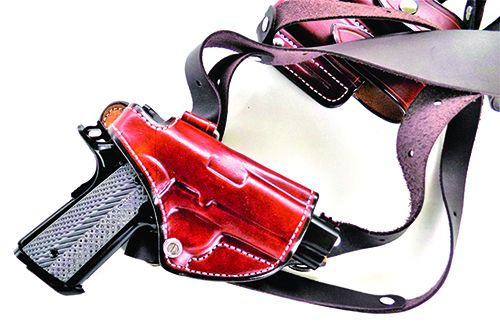
The base price for the Monarch was $275 at AndrewsLeather.com. We added a Knife pouch, $55, and a triple magazine pouch, $125, for the total price as listed above. The Andrews holster is called the Monarch because of the Monarch butterfly–like harness. The Monarch is a classic holster in some ways, but in other ways it is unique. The Monarch is exceptionally well put together. The holster body is lined. While this is critical in protecting the gun’s finish, a holster with a lined interior will wear longer as well. With modern handgun finishes or even older blued-steel handguns, handgun wear isn’t a big issue. Just the same, this is a nice touch. Some of the raters felt that the lined holster made for greater speed.
The holster is also double stitched in certain areas. The blocking and stitching are excellent. Andrews re-designed the shoulder holster to offer greater comfort and less restrictive movement. The Monarch features swivels attached to a wider portion of the leather plate at the top. This subtly different position of the straps helps fight chafing. (Andrews also offers a more traditional Y-strap design.) This holster builds on the shoulder holster concept of spreading the weight of the handgun and the magazines around the body. The shoulder holster must have some means of stabilizing the load. Some inexpensive shoulder holsters require the wearer pull the holster out to maximum extension, or that the weak hand grasp the holster to stabilize it on the draw. This is unacceptable.
Andrews designed a mid-back strap that runs around the lower back and attaches to the magazine carrier and holster components of the harness. This stabilizes the holster well and allows for a rapid, sharp draw. But this system also allows wearing a shorter covering garment as opposed to the belt attachment that demands a long garment. Shoulder holsters are notorious for sagging forward when the user bends over. The holster and magazine pouch of this rig are well stabilized. This holster affords the user a great deal of movement without concern for the holster being exposed. The rear attachment is highly adjustable. We were impressed by the sliding adjustment in the magazine carrier. The holster also features a tunnel loop that allows wearing as a belt holster.
When executing speed draws, we discovered the directional thumb snap and rigid security made for a very sharp draw. The problem with shoulder holsters is comfort on the one side, but on the other side, the holsters do not ride close and secure to the body, which affects concealment. In this case, each problem is neatly solved. We really like the Monarch.
As a side test, we also ordered the three-magazine carrier from Andrews Leather. (Galco offers similar accessories for the Jackass and other should holsters.) We felt that a dual carrier is nice for the 1911. If we were a federal agent or an investigator ranging on long patrols, we might opt for a three- or four-magazine carrier. The Sam Andrews magazine sheath is a good accessory. When adjusting the magazine pouch, we learned that when you don’t need belt attachments and tie downs, the spare magazine carrier may be worn higher under the arm.
Our Team Said: After testing the Andrews rig extensively, we find a good holster, and in some ways a unique interpretation.
GUN TESTS GRADE: A+
DM Bullard Shoulder Holster, $225
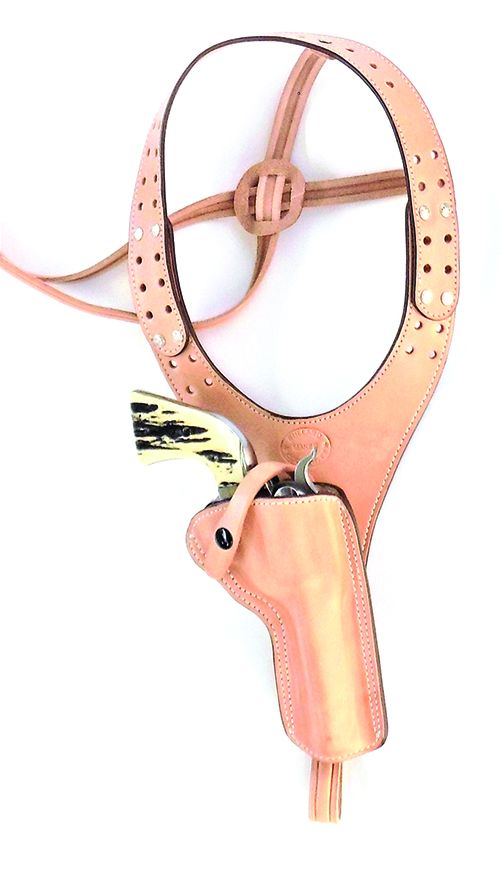
DM Bullard is a true custom shop. Basket-weave and exotic leather patterns may be more expensive, but the holster should perform as well as the one tested. The harness itself lists for $100 and the holster is $125. This allows a shooter to order separate holsters for an outdoors handgun, as one example, or for a concealed carry handgun as another. One of the raters owns a small shop just outside Appalachia and travels a good bit in search of collectibles, antiques, and interesting people. Some of the places get a little too interesting. There is also the chance of meeting a feral dog or even one of the big cats on a trail when he is hiking. His ever-present handgun is a 4.75-inch barrel Ruger New Vaquero in 45 Colt or a Colt SAA 45. He admits the piece is getting a bit heavy in its high-ride holster, so we ordered the DM Bullard rig for this handgun. The logic is if the holster works well with this hogleg, it should work well with any other revolver, and we decided to include at least one revolver holster to see how the cylinder bulge worked out under the arm. This Ruger is a 41-ounce revolver, so the weight is similar to a loaded 1911 steel-frame handgun. The DM Bullard rig is a vertical-type shoulder holster.
The first thing we do with any of the holsters is to lay it out on a work bench, table, or long pattern board. (Pattern boards, either dress or holster, are excellent for comparing measurements.) The overwhelming impression is of quality. Other holsters also have this, too, but the DM Bullard (BullardLeather.com) has certain traits that are unique. As an example, the loops are not plain flat shoulder loops, but instead have the center raised, forming two parallel sections that lay on the shoulder. This is accomplished with a creasing machine. This allows easier changing of the Chicago screws and adjustment. The effect is difficult to describe, but it makes for greater comfort as well. The adjustments are simple and effective. Extra Chicago screws are included to allow the user to make multiple adjustments and as a hedge against losing a set. The holster itself may be worn on the belt if desired, and works okay in that role. There’s double stitching on the edges and single stitching on the holster mouth. The fit to the handgun is excellent. A retention strap is included, but it may be removed. We did not feel it was needed for the majority of the uses the should holster would be put to. If hiking, where there is a chance of a spill, it is a good option, or when using an ATV perhaps. For normal driving and walking, it isn’t needed in this vertical design. A vertical shoulder holster requires the holster be fastened to the belt. The belt fastener works well for this task.
While the handgun is secure when worn under the coat, the draw is fast enough for most of us. The handgun hangs a bit lower than the armpit, preventing the holster from sitting in a hollow and tilting. The main component of the holster is steel lined, making for a rigid platform. The overall hang of the holster is ideal for a heavy revolver. The rater ordering the holster and another rater each wore the holster for the proscribed period, and the primary rater interested in the holster kept it and will use it during the winter. He added a belt loop for 45 Colt cartridges that simply slid onto the shoulder loop, but after wearing it for a time went back to belt carry of the cartridges, just in front of the belt attachment.
Our Team Said: The DM Bullard holster stands out from the crowd in many ways and is the best combination for both field/hunting and concealed carry of a heavy revolver. The rater made a good point — older people often wear a covering garment even during warmer weather. This sartorial choice works out well for a shoulder holster.
GUN TESTS GRADE: A
Lobo Gunleather Deputy, $215
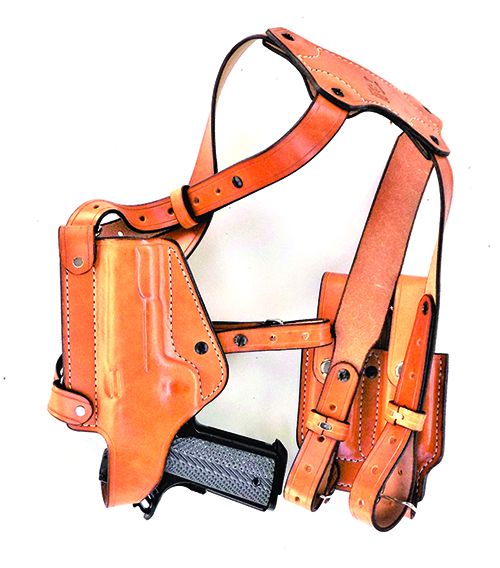
You can find this holster at LoboGunleather.com. Lobo offers a standard shoulder holster and also a vertical shoulder holster. The Deputy is designed for use by law enforcement and anyone needing a holster that will not lose its handgun or magazine payload in rigorous action. The Deputy succeeds in the design goal. The Lobo holster features a well-made carrier that meets in the back, high between the shoulders, for comfort. The loops are wide for comfort and spread the weight of the Government Model 45 pistol out well. The loops are attached to the holster by a ring in a loop set up. This allows a lot of flex in the attachment during movement, but the holster hangs at the correct draw angle when the user is standing. The belt attachments follow the same design and offer plenty of adjustment. We were impressed by the level of adjustment and also by the keeper system found on the shoulder loops. This system, similar to a high-grade target rifle sling, makes for easier adjustment than some without resorting to moving the Chicago screws. This is a good touch that we all liked.
Our Team Said: Our law-enforcement veteran noted the chromed components and keepers just looked like something a cop would wear. Perhaps, but they are sturdy and make for both good adjustment and a bit of flex as the owner moves. We like this set up. The primary difference between this holster and the Wright Leather Works, as an example, is the speed of which spare magazines may be drawn. One is faster, the Wright, one more secure, the Lobo, and the user must make his mind up about which is the better choice.
GUN TESTS GRADE: A
Galco Vertical Shoulder Holster, $190
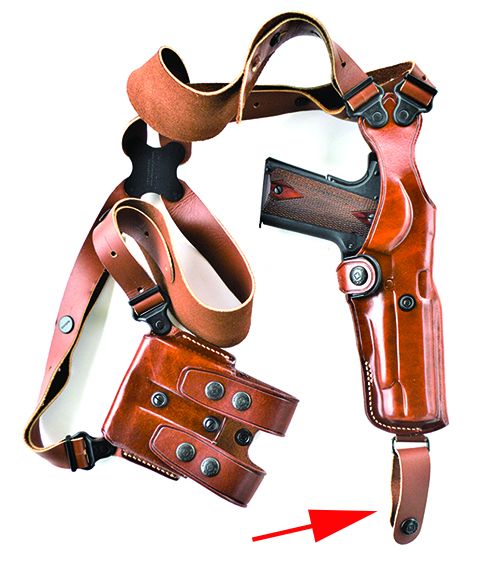
We got this unit from OpticsPlanet.com. We felt that a direct comparison of a vertical shoulder holster and a horizontal type from the same maker would make sense. The Galco vertical shoulder holster arrived in a blister pack and must be assembled. This is a good thing because, with care, the proper adjustment may be had more quickly than taking the holster apart and then reassembling it. After assembling the holster and adjusting it a handful of times, we had a good fit. Then one rater passed it to the other and it was tight, and he also adjusted the holster. The holster doesn’t use Chicago screws, but instead employs plastic tabs that slip into one tab and through and then into the next strap. This is faster and easier than unscrewing the Chicago screws with each adjustment. Is it as secure? We had no problems in our testing.
The vertical holster has a different feel. It must attach to the belt, and the gun handle is presented in the same manner as a crossdraw, save much higher. The fit and finish of the Galco holster are excellent. The holster could not use a thumb break due to its design, so a snap that runs across the gun between the trigger guard and the muzzle is used. This is good for security. However, a speedier draw for most body types is to draw the handgun straight up out of the holster. If you use the snap, the third finger may unsnap the security strap and the handgun may be angled out of the holster. This isn’t as fast as a horizontal holster for most of us, although for some raters it was faster when seated.
The overall comfort level is good with this holster. We simply prefer the horizontal holster for concealed carry. We like the Jackass type better. Just the same, for those who prefer a vertical holster, the Galco design works well and the quality of the leather and straps are excellent. We also felt that the horizontal holsters generally were more comfortable at the end of the day, and that when you have a holster that must be attached to the belt, concealment is lessened. Other raters felt that security was better with the horizontal holster and some preferred the draw. While the holster is a first-rate vertical type, we rated it down a half grade on speed compared to the horizontal shoulder holster. On a final note, more than half the raters said that a great advantage of the Galco Vertical shoulder holster is that when the handgun is carried, the muzzle does not sweep others near the gun carrier. That makes designs like the Galco Vertical holster a top choice for shooters uncomfortable with the horizontal holster. Also, we are all familiar with solid thunk sometimes heard when a gun carrier sits heavily at a table. It isn’t the best thing to do in a restaurant. On a couple of occasions the raters, when sitting down, leaned over as they sat and the gun butt thunked the table. And these are very well designed horizontal shoulder holsters! This did not occur with the vertical holsters.
Our Team Said: The lower rating of this holster is a result of the majority of the raters in agreement, but a minority was vocal in support of this type for top choice.
GUN TESTS GRADE: A-
Nightingale Sandpiper, $375
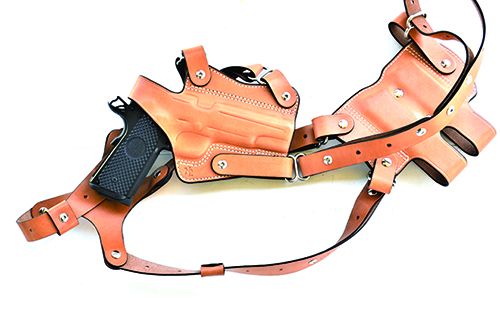
Available from NightingaleLeather.com, the Sandpiper is a modular holster that allows the user to add different holsters and magazine carriers at a later date. This is a popular selling point of the high-end holster. The holster features an adjustable harness and “butterfly” plate. Important features include a reinforced thumb-break retention strap, a well-defined sight channel, and tension screws on the magazine holder. There are touches on the Sandpiper that we really like, but they also add to the time and effort involved in crafting the holster, so only the end user will answer the question of value versus expense. The holster is secured to the harness in a solid fashion. There is some play as the wearer moves, and there must be for the holster to fit properly. This is a challenge when crafting the shoulder holster. It isn’t designed to fit as tightly as possible in the manner of a strong-side Avenger holster, as an example. The shoulder holster must be tight against the body for concealment, but at the same time it must flex some because this is the nature of the load-bearing harness.
The molding of the holster to the handgun is excellent. A thumb break demands reinforcement or it will fold against the body when manipulated to release the handgun. The Sandpiper features a separate leather piece sewn to reinforce the thumb break. We feel that this is an elegant solution compared to the more common plastic or metal reinforcement. While quite strong, there is plenty of flex as well. The holster is double stitched and the blocks that end stitching are well done. We liked the combination of retention straps and tension screws with the magazine carrier. This is more attention to detail, and it is the type of detail that results in a very advanced rig that has left nothing to chance. This also adds to the total price. The Sandpiper also features a hanging strap that runs over the back to stabilize the holster. While this is a great design feature we appreciated, we also tested the Sandpiper without this component.
Our Team Said: The holster still worked well. It worked better for most body types with the strap attached. This is a good design well worth its price.
Which is superior, the Viper, DM Bullard, or Galco Vertical holster, or the Wright Maverick, Galco Jackass, Sam Andrews Monarch, Lobo, or Nightingale Sandpiper horizontal shoulder holster? Well, it isn’t that easy to answer. The vertical holster is possibly the most concealable, even with the consideration that they may need to be anchored to the belt, but they are more difficult to use quickly and achieve a good grip on the draw. The horizontal holster features the gun butt tilted and fairly forward. For most of us, concealment is good with a relatively short-barrel handgun. The raters voted 75% for the horizontal holster, but the minority favoring the vertical holster were convinced their choice was correct.
In the end, we think this comparison wound up more as a critique of shoulder-holster orientation than a comparison of high-end shoulder holsters themselves. There were none that gave a problem, so you’ll have to try them on to see what works best for you. But we recommend you include the Sandpiper in your choices.
GUN TESTS GRADE: A
Written and photographed by Gun Tests staff.




























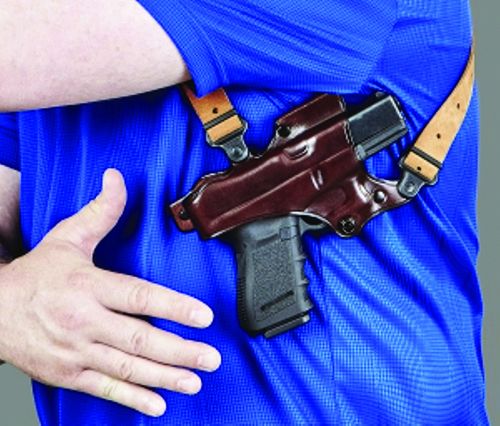


Pretty darn good assessment of shoulder holsters. I have used several over the years, working as a PI. They horizontal shoulder holsters print too easily IMHO.Shorter pistol work better but still will print, depending on the wearers chest thickness. The vertical conceal better- all need to be attached to the belt for a proper draw. I never used the muzzle pointing to my armpit. Drawing from sitting position in a car is much easier from a horizontal, vertical or cross draw holster than a belt holster, although some abdominal type are pretty efficient.
I have never liked the horizontal holster. IMO it violates Rule 1 at all times. Try taking a class and sitting behind someone with a Glock 45 pointing at your face all day.
R.E. shoulder holsters.
In the mid-to-late-‘80s I was frequently posted to Central and South America. I was issued a Galco horizontal shoulder holster. I forgot it one time. I bought an El Cheapo nylon one from a well-known manufacturer, but it barely served my needs and the Velcro tabs abraded my clothing.
Upon return, in Florida, I found another Galco horizontal model, but expressed my discontent with it.
First, horizontal carry puts the gun butt hanging down. Should the security snap fail, the gun will fall out. The second reason is, as you discussed, that the muzzle covers people all around. Drawing under pressure it is possible to prematurely pull the trigger. My employer reported two such events. Both resulted in burns and holes in clothing, but no injuries.
One positive experience was with a young lady that had somewhat larger than usual breasts for her size. She could readily conceal two Sig P239/9mm guns in Galco horizontal holsters under a jacket.
I subsequently bought my own Galco vertical carry model that worked well for me. Changes in issued guns and assigned duties made them unsuitable to me and I returned to IWB and OWB holsters, which were becoming highly diverse and adaptable.
Upon retirement I was presented with a dual-holster horizontal shoulder rig fitted for guns I no longer carried. It was made by Andy Arratoonian, and is high quality. He refused to include attachments for belts. I was told he said “no tiedowns” or look elsewhere!
I was able to make some small modifications to fit guns I carry to this day, but Reason Number 1 now rears its head as the retention snaps are getting weak and I fear one letting go and releasing my gun.
With that in mind I recently ordered one from Craft Holsters, featuring a vertical holster that rotates as the gun is drawn. I tried one that a friend had for his Glock and thought it worked well. I could report on mine for you if you wish, after I receive it and wear it for a while. It is being made for my Sig 1911 Fastback Emperor Scorpion Carry/357Sig that closely replicates the dimensions of the Colt 9mm Lightweight Commander.
Jan Gerstner
Delafield WI
Todd, Why don’t you show the shoulder holsters with a person wearing them? A holster on a table doses nothing for me. Mike Hudson, Texas
Thanks for the safety tip regarding stance and raising the support arm. I’d appreciate a recommendation for a reliable upside-down shoulder holster for an S&W 638-3, the older Bodyguard model with the protective hump that exposes only the tip of the hammer.